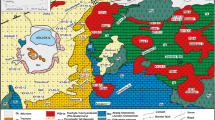Abstract
-
1.
Xenoliths of ultrabasic, ultramafic, gabbroic or syenitic type occur in Teneriffe: dunites and clino-pyroxenites in the old alkalic basalt formations of Teno and Anaga peninsulas; gabbroic xenoliths in the Pedro Gil region; nepheline-syenite xenoliths in the Las Canadas and Vilaflor regions where intermediate and phonolitic lavas are abundant; ultramafic, clino-pyroxenite and syenitic xenoliths in the Anaga peninsula where there are many intrusions of nepheline-syenite and phonolitic syenite. Several xenoliths show signs of cataclasis, recrystallisation or reaction of their minerals with the host liquids.
-
2.
The ultrabasic, ultramafic and anorthoclase-rich xenoliths appear to be of cumulus origin, subtracted from basic to intermediate alkalic liquids. Major cumulus phases are: magnesium-rich olivine, sub-silicic, aluminous pyroxene, titanomagnetite, sub-silicic potassic kaersutite, and anorthoclase. It is suggested that the xenoliths formed at depths between 11 km and 30 km, largely under wet conditions that helped suppress formation of cumulus plagioclase.
-
3.
The subtraction of kaersutite from liquids of intermediate composition is thought to be a means of producing the gap in silica content between the Teneriffe trachybasalts and the more siliceous trachyphonolites and phonolites. It is also suggested that the subtraction of kaersutite and anorthoclase would considerably deplete residual liquids in alumina whilst enriching then in soda and this might be the means of producing peralkaline liquids.
-
4.
The presence of the xenoliths supports the geophysical data that indicated that Teneriffe has a sub-crustal structure of plutonic rocks. Correlation of the Teneriffe plutonic xenoliths with exposed plutonic basement rocks from other Canary Islands, which are believed to have similar sub-crustal structures, is considered necessary.
Similar content being viewed by others
References
Bennell, M. J.: Ultrabasic and basic nodules from the Azores. Proc. Geol. Soc. London 1658, 252–253 (1969).
Bosshard, E.: Unpublished thesis, University of London, 1969.
Bravo, T.: Estudio geologico y petrografico de La Isla de la Gomera, 11. Petrologia y Quimismo de Las rocas volcanicas: Estud. Geol. 20, 23–56 (1964).
Cendrero, A. : The volcanic complex of La Gomera, Canary Islands. Abstracts, IAVCEI Symposium, 218 (1969).
Dash, B. P., Bosshard, E.: Crustal studies around the Canary Islands. Proc. Inter Geol. Congr. 23rd Session, Czechoslovakia, 1, 249–260 (1968).
Duncumb, P., Reed, S. J. B.: The calculation of stopping power and backscatter effects in electron-probe microanalysis. Tube Investments Res. Lab. Technical Rep. No. 221 (1967).
—, Shields, P. K.: Effect of critical excitation potential on the absorption correction. The electron microprobe, p. 284–295. New York-London: Wiley 1966.
Frisch, T., Schmincke, H. U.: Petrology of clinopyroxene-amphibole inclusions from the Roque Nublo volcanics, Gran Canaria, Canary Islands. (Petrology of Roque Nublo Volcanics 1.) Bull. Volcanol. 33 (sn4), 1073–1088 (1969).
Fuster, J. M., Paez, A., Sagredo, J.: Significance of basic and ultramafic rock inclusions in the basalts of the Canary Islands. Bull. Volcanol. 33 (sn3), 665–693 (1970).
Gilbert, M. C.: Reconnaissance study of stability of amphibole at high pressure. Carnegie Inst. Wash. Yearbook 67, 167–170 (1969).
Green, T. H., Ringwood, A. E.: Genesis of the calcalkaline igneous rock suite. Contr. Mineral. and Petrol. 18, 105–162 (1968).
Hausen, H.: Contributions to the geology of Teneriffe. Soc. Sci. Fennica Commentationes Phys-Math. 18 (sn1), 247 (1956).
Heinrich, K. F. J.: X-ray absorption uncertainty. The electron microprobe, p. 296–377. New York-London: Wiley 1966.
- Abstracts of the 2nd National Conference on Electron Microprobe Analysis, Boston (1967).
Ibarrola, E., Viramonte, J.: Sobre el Hallazgo de sienitas nefelinicas en Tenerife (Islas Canarias). Estud. Geol. 23, 215–222 (1967).
Jackson, E. D.: Character of the lower crust and upper mantle beneath the Hawaiian Islands. Proc. Inter. Geol. Congr. 23rd Session, Czechoslovakia 1, 135–150 (1968).
Kuno, H.: Mafic and ultramafic nodules in basaltic rocks of Hawaii. Geol. Soc. Am. Mem. 115, 189–234 (1969).
Kushiro, I.: Formation of amphibole in peridotite compositions Carnegie Inst. Wash. Year book 68, 245–246 (1970).
LeMaitre, R. W.: The significance of the gabbroic xenoliths from Gough Island, S. Atlantic. Mineral. Mag. 34, 303–317 (1965).
—: Kaersutite-bearing plutonic xenoliths from Tristan da Cunha, S. Atlantic. Mineral. Mag. 37, 185–197 (1969).
Lovering, J. F., White, A. J. R.: Granulitic and eclogitic inclusions from basic pipes at Delegate, Australia. Contr. Mineral. and Petrol. 21, 9–53 (1969).
Mason, B.: Kaersutite from San Carlos, Arizona, with comments on the paragenesis of this mineral. Mineral. Mag. 36, 997–1002 (1968).
Mason, P. K., Frost, M. T., Reed, S.: National Physical Laboratory Report I.M.S.2. (1969).
MacFarlane, D. J.: Unpublished thesis, University of London (1969).
—, Ridley, W. K.: An interpretation of Gravity data for Teneriffe, Canary Islands. Earth Plan. Sci. Letts. 4, 481–486 (1968).
Middlemost, E. A. K.: Volcanics and associated rocks of San Miguel de La Palma, Canary Islands. Proc. Geol. Soc. London 1658, 254–256 (1969).
Reed, S. J. B.: Characteristic fluorescence corrections in electron probe microanalysis. Brit. J. Appl. Phys. 16, 913–926 (1965).
White, R. W.: Ultramafic inclusions in basaltic rocks from Hawaii. Contr. Mineral. and Petrol. 12, 214–314 (1966).
Wilkinson, J. F. G.: Some aspects of the calciferous amphiboles Oxyhornblende, Kaersutite and Barkevikite. Am. Mineralogist 46, 340–354 (1961).
Author information
Authors and Affiliations
Rights and permissions
About this article
Cite this article
Borley, G.D., Suddaby, P. & Scott, P. Some Xenoliths from the alkalic rocks of Teneriffe, Canary Islands. Contr. Mineral. and Petrol. 31, 102–114 (1971). https://doi.org/10.1007/BF00373453
Received:
Issue Date:
DOI: https://doi.org/10.1007/BF00373453




